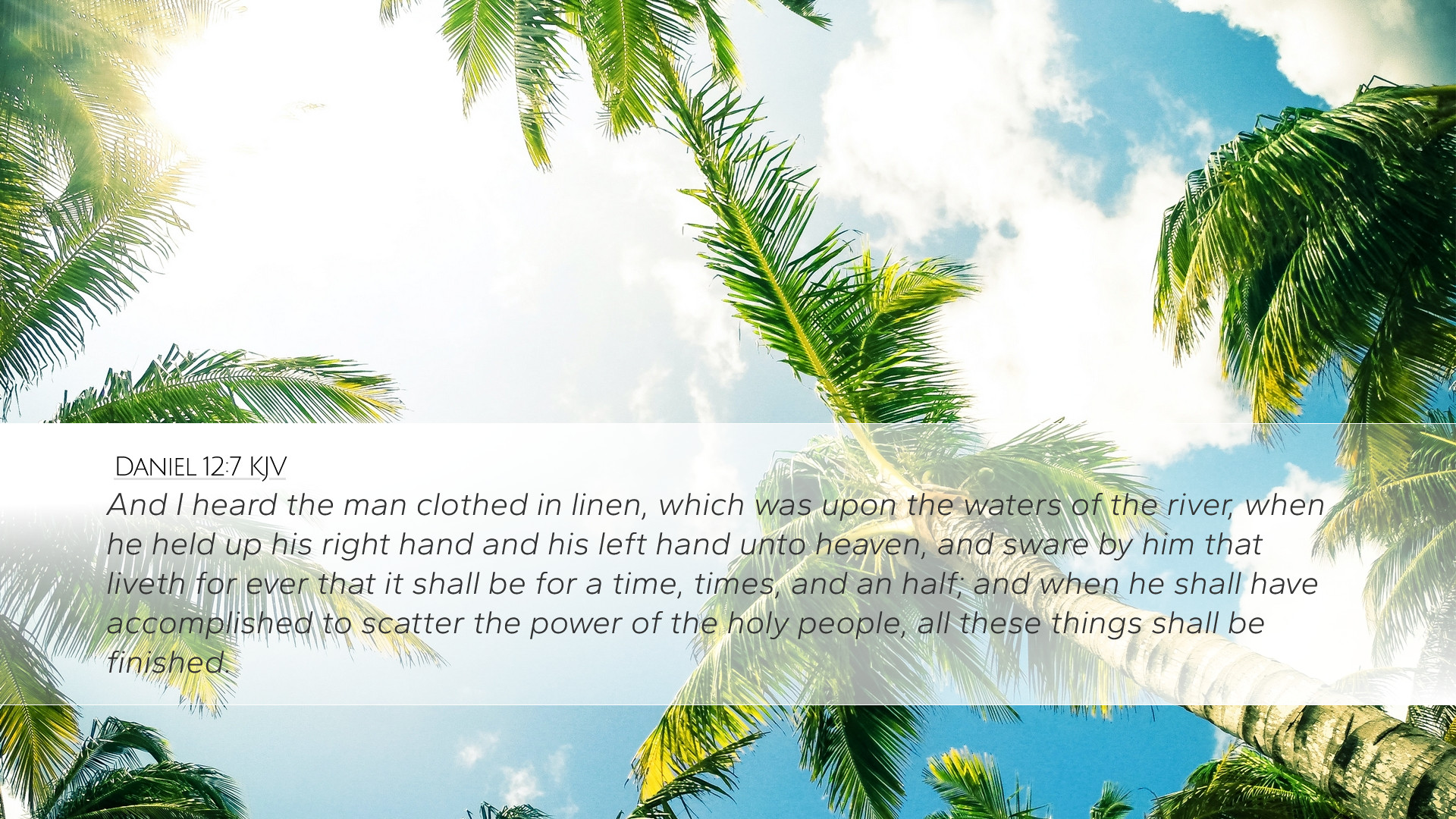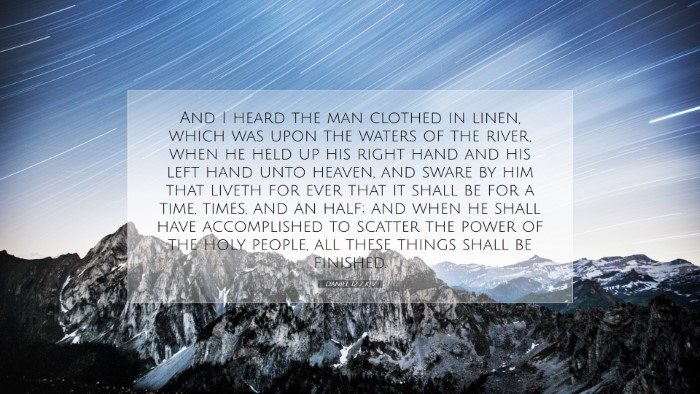Old Testament
Genesis Exodus Leviticus Numbers Deuteronomy Joshua Judges Ruth 1 Samuel 2 Samuel 1 Kings 2 Kings 1 Chronicles 2 Chronicles Ezra Nehemiah Esther Job Psalms Proverbs Ecclesiastes Song of Solomon Isaiah Jeremiah Lamentations Ezekiel Daniel Hosea Joel Amos Obadiah Jonah Micah Nahum Habakkuk Zephaniah Haggai Zechariah MalachiDaniel 12:7
Daniel 12:7 KJV
And I heard the man clothed in linen, which was upon the waters of the river, when he held up his right hand and his left hand unto heaven, and sware by him that liveth for ever that it shall be for a time, times, and an half; and when he shall have accomplished to scatter the power of the holy people, all these things shall be finished.
Daniel 12:7 Bible Commentary
Commentary on Daniel 12:7
Verse Text: "And I heard the man clothed in linen, which was upon the waters of the river, when he held up his right hand and his left hand unto heaven, and swore by him that liveth for ever that it shall be for a time, times, and a half; and when he shall have accomplished to scatter the power of the holy people, all these things shall be finished."
Introduction
The last chapter of Daniel delivers a profound revelation concerning the end times, specifically touching on the final period of tribulation that God's people will endure. Daniel 12:7 is pivotal, illustrating a heavenly oath that conveys the certainty of God's plan amid adversity. Commentary from various public domain sources enriches our understanding of this verse, delving into the imagery, symbolism, and theological implications encapsulated within this passage.
Contextual Analysis
In interpreting Daniel 12:7, it is crucial to consider the broader context in which this prophecy resides. This chapter marks the culmination of the visions that Daniel has received, particularly addressing the end of the age and the ultimate victory of God's kingdom over earthly adversities.
Historical Background: Daniel was a prophet who lived during the Babylonian exile, and his prophecies often depict times of suffering for the Jewish people, culminating in hope and restoration.
The Figure of the 'Man Clothed in Linen'
The figure described as "the man clothed in linen" is reminiscent of Christ or an angelic messenger, emphasizing purity and holiness. According to Matthew Henry, this figure represents a heavenly being conveying important revelations regarding the end of time. The act of being "upon the waters of the river" symbolizes divine authority and the transcendental nature of God's counsel to His people.
Symbolism of the Right and Left Hands
The raising of both hands to heaven is significant. It signifies an oath, demonstrating the seriousness of the message being conveyed. Albert Barnes highlights that such an act is a customary expression of making a covenant—emphasizing the truth of God's promises that will come to fruition. This duality of hands also symbolizes the completeness of God’s purpose.
Understanding 'Time, Times, and a Half'
The phrase "time, times, and a half" is often interpreted as a period of intense suffering for the saints, generally understood to be 3.5 years or 1260 days. Adam Clarke notes that this is a significant eschatological timeframe often associated with the Great Tribulation. This period denotes both trial and divine protection as God’s ultimate plan unfolds.
The Scattering of the Power of the Holy People
The declaration that this time will "scatter the power of the holy people" indicates a time when God's people will face trials and persecution, but also signifies a turning point where God's sovereignty is confirmed amid such adversities. Matthew Henry comments that this scattering serves a divine purpose—refining and purifying the remnant, ultimately leading to restoration and victory over their adversaries.
The Finale: 'All these things shall be finished'
The conclusion of this verse promises that when God's purposes are fulfilled, all things will reach completion. This ties back to the overarching theme of the Book of Daniel, where God reveals that history is in His hands, and at the appointed time, He will bring everything to completion. Albert Barnes underscores that the fulfillment of divine prophecy reinforces the faith of believers, providing hope in times of trouble.
Theological Implications
This verse serves as a reminder of God's covenant faithfulness. The oath taken by the heavenly messenger confirms that despite the seeming chaos of the world, God's sovereign plan is unfaltering. Believers can take solace in the knowledge that God's promises are assured, as stated by Adam Clarke, who emphasizes the importance of trusting in God's timing and His ultimate victory.
The Role of Suffering
Daniel 12:7 also leads to reflections on the role of suffering in the life of believers. It teaches that trials have a purpose, transforming the faithful and preparing them for eternal glory. As they endure, they are called to remain steadfast, knowing that their suffering is temporary but God's plan is eternal.
Conclusion
In conclusion, Daniel 12:7 encapsulates a powerful promise amidst tribulation. The imagery employed, combined with the prophetic timeline, resonates with believers facing challenges, encouraging them to trust in God's providence. As Matthew Henry notes, the promise of God’s ultimate victory brings hope and assurance that, in the end, all things shall be made new. The prophetic words serve not only as a warning but also as an instrument of comfort and certainty regarding the fate of the holy people of God.


